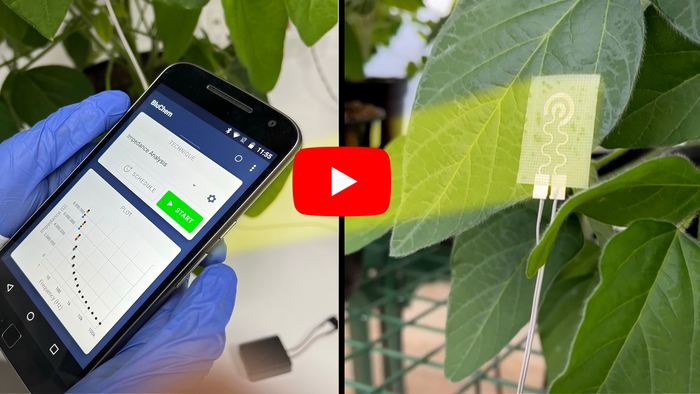Plants can’t speak up when they are thirsty. And visual signs, such as shriveling or browning leaves, don’t start until most of their water is gone. To detect water loss earlier, researchers reporting in ACS Applied Materials & Interfaces have created a wearable sensor for plant leaves. The system wirelessly transmits data to a smartphone app, allowing for remote management of drought stress in gardens and crops. Watch a video of the plant wearables here.

Credit: Video Credit: American Chemical Society
Plants can’t speak up when they are thirsty. And visual signs, such as shriveling or browning leaves, don’t start until most of their water is gone. To detect water loss earlier, researchers reporting in ACS Applied Materials & Interfaces have created a wearable sensor for plant leaves. The system wirelessly transmits data to a smartphone app, allowing for remote management of drought stress in gardens and crops. Watch a video of the plant wearables here.
Newer wearable devices are more than simple step-counters. Some smart watches now monitor the electrical activity of the wearer’s heart with electrodes that sit against the skin. And because many devices can wirelessly share the data that are collected, physicians can monitor and assess their patients’ health from a distance. Similarly, plant-wearable devices could help farmers and gardeners remotely monitor their plants’ health, including leaf water content — the key marker of metabolism and drought stress. Previously, researchers had developed metal electrodes for this purpose, but the electrodes had problems staying attached, which reduced the accuracy of the data. So, Renato Lima and colleagues wanted to identify an electrode design that was reliable for long-term monitoring of plants’ water stress, while also staying put.
The researchers created two types of electrodes: one made of nickel deposited in a narrow, squiggly pattern, and the other cut from partially burnt paper that was coated with a waxy film. When the team affixed both electrodes to detached soybean leaves with clear adhesive tape, the nickel-based electrodes performed better, producing larger signals as the leaves dried out. The metal ones also adhered more strongly in the wind, which was likely because the thin squiggly design of the metallic film allowed more of the tape to connect with the leaf surface. Next, the researchers created a plant-wearable device with the metal electrodes and attached it to a living plant in a greenhouse. The device wirelessly shared data to a smartphone app and website, and a simple, fast machine learning technique successfully converted these data to the percent of water content lost. The researchers say that monitoring water content on leaves can indirectly provide information on exposure to pests and toxic agents. Because the plant-wearable device provides reliable data indoors, they now plan to test the devices in outdoor gardens and crops to determine when plants need to be watered, potentially saving resources and increasing yields.
The authors acknowledge support from the São Paulo Research Foundation and the Brazilian Synchrotron Light Laboratory. Two of the study’s authors are listed on a patent filing application for the technology.
The American Chemical Society (ACS) is a nonprofit organization chartered by the U.S. Congress. ACS’ mission is to advance the broader chemistry enterprise and its practitioners for the benefit of Earth and all its people. The Society is a global leader in promoting excellence in science education and providing access to chemistry-related information and research through its multiple research solutions, peer-reviewed journals, scientific conferences, eBooks and weekly news periodical Chemical & Engineering News. ACS journals are among the most cited, most trusted and most read within the scientific literature; however, ACS itself does not conduct chemical research. As a leader in scientific information solutions, its CAS division partners with global innovators to accelerate breakthroughs by curating, connecting and analyzing the world’s scientific knowledge. ACS’ main offices are in Washington, D.C., and Columbus, Ohio.
To automatically receive news releases from the American Chemical Society, contact [email protected].
Follow us: Twitter | Facebook | LinkedIn | Instagram
Journal
ACS Applied Materials & Interfaces
DOI
10.1021/acsami.2c02943
Article Title
Biocompatible Wearable Electrodes on Leaves toward the On-Site Monitoring of Water Loss from Plants
Article Publication Date
21-Mar-2022


![Nickel-Catalyzed Regioselective Hydrogen Metallation Cyclization of Alkynylcyclobutanones Enables Synthesis of Bicyclo[2.1.1]hexanes](https://bioengineer.org/wp-content/uploads/2025/11/Nickel-Catalyzed-Regioselective-Hydrogen-Metallation-Cyclization-of-Alkynylcyclobutanones-Enables-Synthesis-of-120x86.jpeg)

